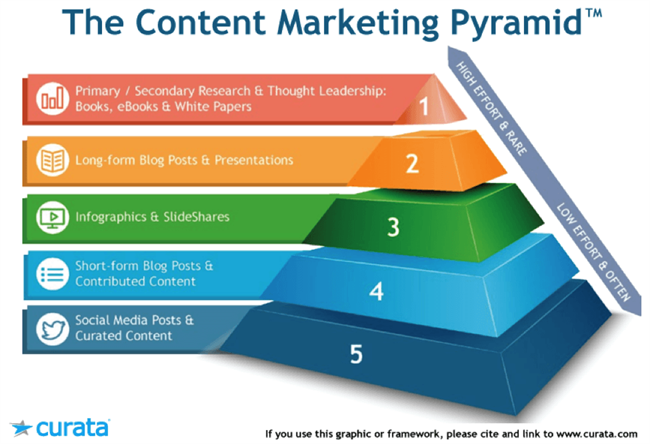How to Organize Your Content Production Pipeline

A content production pipeline is more than simply settling on a series of steps that teams must execute when producing content.
To be effective your production pipeline must be aligned with your content marketing strategy, and your overall organizational strategy. As Content Marketing Institute's 2017 'B2B Benchmarks, Budgets, and Trends report' shows - companies with documented strategies consistently perform better.
A content production pipeline must also include considerations about:
- The type of content that is relevant to your visitors along their buyer's journey
- How to efficiently produce such content
- How to incorporate feedback from your audience
In so many words, your content production pipeline is your content marketing strategy come alive.
Read on for an overview of the main steps you should follow to organize your content production pipeline from start to finish.
How to organize your content production pipeline
1. Adopt a model
Consider adopting an overarching marketing model to make sure your whole content marketing process is internally consistent.
The content marketing pyramid, for example, offers a way for you to get alignment between your organizational objectives, the marketing themes that support them, and the specific content strategies that will be put in place to realize these objectives.
(Image Source)
Adopting a model will help you:
- Organize your content efforts and focus on specific goals and priorities
- Improve your content production by helping you get a better grasp of the resources you have at hand
- Achieve a steady and consistent stream of content that regularly targets different personas at different stages
2. Develop a strategy
The content marketing pyramid provides you with a roadmap for the implementation of your strategy and helps you understand the types and amounts of content you should produce.
At the top of the pyramid you have core content - original content that involves research and/or deep insight. Core content takes up only a small part of your total content but is highly valuable. It is usually gated and is something that buyers are given access to, once they pass a certain point in their journey.
In the middle of the pyramid you have three separate levels of derivative assets:
- long or regular blog posts,
- infographics, presentations, slides,
- and contributed posts all of which are usually not gated.
Derivative assets are usually not behind a paywall and are used for lead generation and lead nurturing. They form a major chunk of your total content. And by offering a mix of content you are also addressing the unique needs that your readers have, allowing you to reach a wider audience.
Finally, at the bottom of the content pyramid, you have promotional microcontent. This type of content includes:
- Social media posts
- Blog comments
- Guest posts
- Promoted links
- Curated blog posts
- Newsletters
- Forum participation
- Any other content that serves to engage your audience and keep you visible
Once you evaluate your current assets, you can begin to think how to structure your subsequent content creation efforts - where to start, what to produce and how to react quickly when you are required to do so.
You could begin by creating Level 1 content and then move down to create derivatives, or you could test the waters with a simpler idea in the middle, and then develop it into something highly valuable.
The choices you make about the content pyramid model will form your overall content marketing strategy. Once your strategy is in place you can move on to creating your workflows that will guarantee its smooth operation.
3. Create workflows
Defining content production workflows can be segmented into three steps. These clarify the roles that are involved in the production of each content type, the various tasks and subtasks, and the process itself.
According to the Content Marketing Institute, a defined workflow provides visibility to all parties involved in the process of creation. It lets everyone know at what stage of the process the content is, when their turn is due, and what's required of them.
A defined workflow can easily be visualized to serve as a 'map', which a project manager can use to follow the production process, and identify bottlenecks.
Step 1: Define the roles
The first step in designing your workflows is deciding who will participate in the production of content. Based on that, you might end up with different workflows for the various type of content you'll be producing.
People who could be engaged in the production of a piece are:
- Project managers
- Strategists
- Copywriters
- Graphic or UX designers
- Marketers
- Editors/reviewers
- Others
The sequence in which these actors will come in and out of the workflow will depend on the type of task(s) at hand.
Step 2: Define the tasks
Break the production of any type of content into tasks and subtasks. Then identify which roles will be engaged in the production and at which stage. Be sure to define each task and subtask as clearly as possible to reduce confusion, and to minimize time waste.
Prepare your quality guidelines, checklists, legal requirements, and share them with your team so they have a clear understanding of what it takes to successfully complete a task. There will always be some back and forth, but the more detail you can provide, the better the process will flow.
Step 3: Define the flow
The flow of the content production is the sequence in which the above tasks and subtasks will be executed, along with projections on the time required for each task. The layers of a flow can range from simple and linear to complex, including feedback loops, revisions, iterations, etc.
The flow is often defined as passing through the following main phases:
- Ideation
- Planning and prioritization
- Creation (includes design)
- Publication and promotion
- Organization and storage
Each of these phases includes several important considerations that you need to be aware of.
- In the ideation phase, you need to make sure that all relevant parties have been included, and that you have a place to store all of the ideas that are generated, even if they are not developed into content right away. You must also define clear processes around who approves and reviews ideas, and moves them down into the planning phase.
- For the planning and prioritization phase, you must appoint someone who will keep an overview of the editorial calendar, plan which content should be published and when. That person should also be in touch with other teams (such as sales), to prioritize content production.
There might be certain instances where you need to re-prioritize your workflow. For example, if you are launching a product, you may need to interrupt the regular flow to prioritize content about the product. Ideally, you should plan for these interruptions as well so that they don't catch you unprepared.
- During the creation phase, you need to map out the various stages that a piece of content goes through before it is finished. These will vary depending on the types of content, so you may want to create different workflows for each. The creation stage should ideally leave room for reviews, iterations, and the like, so that your creatives feel they have enough space to focus on their work without stressing out.
- For the publication and promotion phase, you will need a range of possible actions depending on the type of content being promoted. You may decide against paid promotions for simpler content, but gated content will require additional promotion.
During this phase, you will also need to monitor and analyze the performance of your content, based on meaningful content distribution metrics. These metrics will help you draw the right conclusions for improvements to your workflow or to the distribution itself.
- Finally, for the organization and storage phase, you need to have clear guidelines about where and how content is kept, how it is named and organized. This will enable you to have easy access to it whenever you need it - if, for example, you decide to repurpose it later or update it and run it again.
Some best practices to include when designing the 'flow' are:
- Define clear deadlines in all phases (but allowing for fluidity if things get complicated)
- Notify all parties involved in the production of a particular piece of content that it will be produced and they will be part of it
- Make sure everyone knows what their role and responsibilities are
- Develop a visible and well-structured map of the whole workflow so that every party knows where they are and what they need to do next
Step 4: Use tools
You don't need to figure all of this out yourself. Tools are an essential component to any content marketing workflow, but you must find the right mix of tools that work for you.
There are plenty of good tools that can help you along each of the above phases: from developing your strategy, and organizing your workflow, to creating and optimizing your content, and measuring its performance.
Don't jump into adopting a certain tool before testing it thoroughly. Some tools may have an unforeseen impact on your workflow that may be hard to overcome once created. They may slow it down, create bottlenecks, introduce elements that are foreign to your workflow, etc. Always test tools on a smaller scale, and if they work, roll them out gradually.
Overarching Content Model
Your content production pipeline is made up of all of the above elements. It is shaped by an overarching content model that creates a frame for you to think about content marketing. It is informed by your content strategy that defines what types of content and in what amounts you will be creating.
It is put into practice through your content workflows that determine the creation of content from its conception as an idea to its organization and final storage. It is assisted by the use of various tools, and its success is determined by meeting the objectives defined by the metrics you have opted to track.
To be successful your content production pipeline needs to include all of these steps in some form. And as a final piece of advice, keep in mind that as you create and implement your pipeline, you should not forget to revisit your strategy and model regularly to find weak elements that need to be conceptualized differently. This will make your pipeline a truly functioning system.









